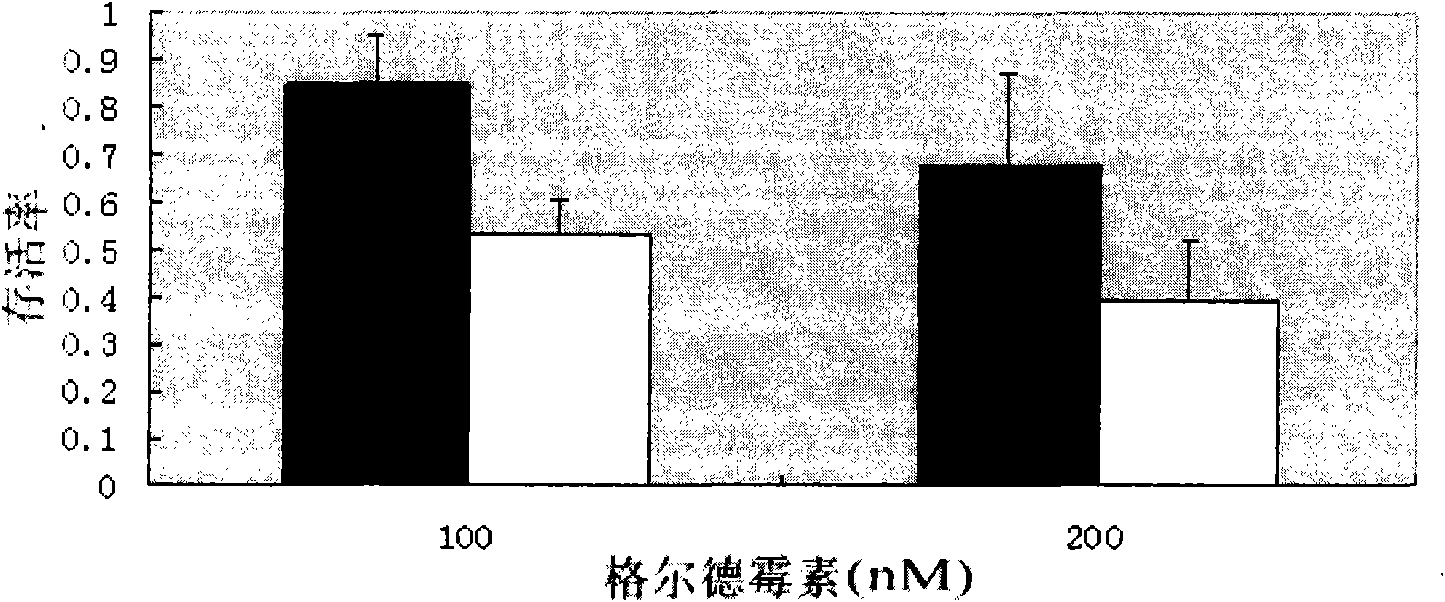Medicinal composition having tumor-resistant synergy
An anti-tumor drug, synergistic technology, applied in the direction of anti-tumor drugs, drug combinations, medical preparations containing active ingredients, etc., to achieve a significant tumor inhibitory effect
- Summary
- Abstract
- Description
- Claims
- Application Information
AI Technical Summary
Problems solved by technology
Method used
Image
Examples
Embodiment 1
[0055] Synergistic inhibitory effect of lidamycin and geldanamycin on SKOV-3, MCF-7 and Bel-7402 cells
[0056] The above cells in the logarithmic growth phase were digested, counted, and spread on a 96-well plate. After 24 hours, different concentrations of drugs were added, and the culture was continued for 72 hours. MTT (tetrazolium blue) was added, incubated at 37°C for 4 hours, and DMSO was added. (dimethyl sulfoxide) to dissolve the blue-purple particles, and measure the absorbance at 570 nm in each well on a microplate reader. The OD value of each test well was subtracted from the background OD value (complete medium plus MTT, no cells), and the OD value of each parallel well was averaged. The survival rate of the cells is represented by T / C (%), T is the OD value of the drug-treated cells, and C is the OD value of the control cells. Cell viability%=(medicated cell OD-background OD) / (control cell OD-background OD)×100%.
[0057] Calculate the interaction coefficient...
Embodiment 2
[0059] Hsp90 inhibitor enhances the effect of lidamycin-induced apoptosis
[0060] In normal living cells, phosphatidylserine (phosphotidylserine, PS) is located on the inner side of the cell membrane, and once apoptosis is initiated, PS becomes an early apoptosis signal. Annexin V is a Ca with a molecular weight of 35-36kD 2+ Dependent phospholipid-binding protein, in the process of apoptosis, can specifically bind with high affinity to PS that is exposed to the extracellular environment from the inside of the cell membrane to the surface of the cell membrane. Propidiumiodide (PI) is a nucleic acid dye that cannot penetrate the intact cell membrane, but it can penetrate the intact cell membrane and stain red in the late stage of apoptosis and dead cells. Annexin V is labeled with FITC fluorescein as a fluorescent probe and used in combination with PI to distinguish living cells, early apoptotic cells, late apoptotic cells, and dead cells.
Embodiment 3
[0075] Hsp90 inhibitors enhance the ability of lidamycin to cleave DNA by inhibiting post-DNA repair repair.
[0076] Cells were pretreated with geldanamycin for 16 hours and then treated with lidamycin for different times. γH2AX is one of the earliest proteins bound to DNA double-strand breaks, and the amount of γH2AX is usually used to indicate the degree of DNA double-strand breaks. The level of intracellular γH2AX was detected by immunofluorescence, and the operation was as follows:
[0077] 1) Inoculate cells in a 6-well cell culture plate;
[0078] 2) 37°C environment with 5% CO 2 Cultivate in the incubator of concentration for 24h;
[0079] 3) According to the needs of the experiment, the cells were treated with drugs at different times, lidamycin and geldanamycin or a combination of the two;
[0080] 4) Wash 3 times with PBS, 5 minutes each time;
[0081] 5) Fix with 4% paraformaldehyde for 30 minutes;
[0082] 6) Wash 3 times with PBS, 5 minutes each time;
...
PUM
| Property | Measurement | Unit |
|---|---|---|
| wavelength | aaaaa | aaaaa |
Abstract
Description
Claims
Application Information
 Login to View More
Login to View More - R&D
- Intellectual Property
- Life Sciences
- Materials
- Tech Scout
- Unparalleled Data Quality
- Higher Quality Content
- 60% Fewer Hallucinations
Browse by: Latest US Patents, China's latest patents, Technical Efficacy Thesaurus, Application Domain, Technology Topic, Popular Technical Reports.
© 2025 PatSnap. All rights reserved.Legal|Privacy policy|Modern Slavery Act Transparency Statement|Sitemap|About US| Contact US: help@patsnap.com



